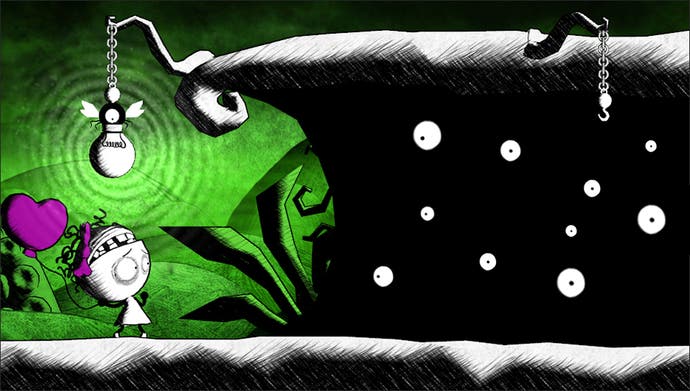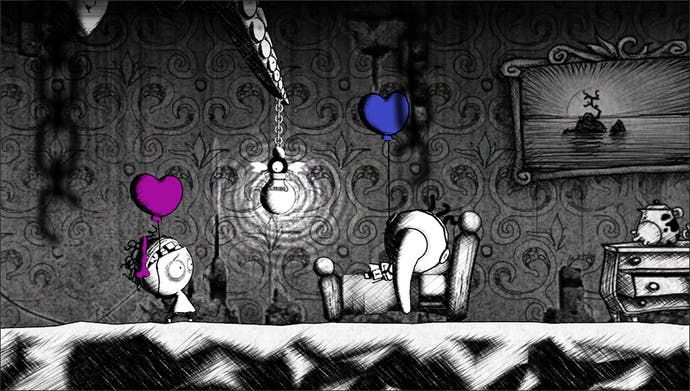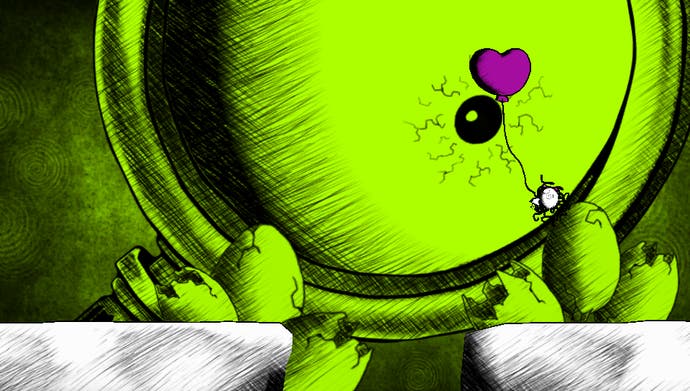Murasaki Baby review
Sweet child of mine.
Early childhood is a daunting time, full of unfamiliar experiences, bewildering potential and the very real possibility that there are monsters living under the bed. Murasaki Baby neatly encapsulates all of these characteristics, along with the notion that childhood is when most parents stand as infallible bastions of safety and comfort. As such, your overarching goal is to reunite Baby with her mother, but that's a bit like saying that the point of Journey is to reach the top of a mountain.
Over the course of two and a half hours, this puzzle-platformer goes on to explore parenthood, trust, responsibility and the wrenching realisation that, try as you might, you cannot always keep a child safe from harm. It's affecting but it's also more than a little odd; screenshots will tell you that much but they can't fully convey just how effective Baby's journey is at simultaneously eliciting feelings of protectiveness and bemused unease.

While Murasaki Baby's thematic identity is constantly reaffirmed by these concepts, its mechanical nuts and bolts are inextricably tied to the Vita's unique features and so are occasionally liable to minor hiccups. Guiding Baby by the hand is simply a matter of reaching out via the touch-screen and leading her around as she takes her first tentative steps in a world that has been pulled from some half-remembered fever dream. She can be made to walk or run, but over-stretch her peculiarly elastic arm and she'll tumble to the ground. Then, as she picks herself up, dusts down her small dress and laughs nervously when you reach for her hand once more, you feel sufficiently guilty for making her fall and pledge to do better in future. It's here that the game feels most like an Edward Gorey illustrated guide to parenting.
The key to protecting Baby against the many nightmarish visions is keeping the balloon that she clutches away from environmental hazards and prowling menaces. You swipe to jump obstacles (platform jumps are performed by Baby automatically), tap to swat down pesky flying sentient safety pins and hold on to the balloon when strong winds threaten to blow Baby off-screen. Many times you'll have to guide baby with one finger while manoeuvring the balloon away from low-hanging thorns or raging fire and it's here that things can get a little clumsy as your hands get in the way or you lose control of one or the other as you shift position. Baby's adventure is played primarily at your own pace and rarely asks you to perform finger gymnastics at high speed, but while checkpoints are frequent it can still be frustrating to have that balloon go pop because of perceived control issues.

Murasaki Baby's bold hand-drawn visuals mix the cute and the perverse as its expressive characters stand stark against the block swathes of colour that form its backgrounds. This isn't just for visual effect, though, as the background theme makes up Murasaki Baby's key feature. By swiping the rear touchpad, the colour and mood of the background can be changed, while tapping the touchpad reveals a unique action. This ranges from simple rain, snow and wind effects that have multiple puzzle applications, to more offbeat occurrences, like distracting a child in a monster suit so Baby can sneak past, turning the balloon to stone to serve as a weight or causing a giant to jump to shake the screen and destroy obstacles. Some of these effects have a detrimental effect on Baby or her balloon, but experimentation is key to the enjoyment of the game and so it's up to you to discover what works where.
For the most part, developer Ovosonico has achieved a delicate balance of introducing varied ideas that rarely repeat. Each of the game's four distinct areas has its own effects and key characters that require help and each area slowly introduces additional backgrounds and incorporates them to form more complex solutions. None venture into genuine head-scratching territory, but most complement the twisted narrative and keep things at a comfortable pace. Nonetheless, by the final level of each area it's necessary to switch between three or four backgrounds to overcome obstacles and solve puzzles to extricate characters from peculiar binds.

Underpinning all of this is the offbeat soundtrack, and particular mention must go to composer Gianni Ricciardi, whose tracks and ambient effects greatly enhance the sense of unease and hope that permeates your time with Baby. Acclaimed Silent Hill composer Akira Yamaoka has also been brought on board to write the game's end-credits track and his influence can also be felt in Ricciardi's use of effects throughout.
Played with earphones, no distractions and in a single sitting, Murasaki Baby proves engaging and compelling, its brevity and variety leaving you wanting more. There are no hidden collectables or alternate routes through the game and yet its uniqueness is enough to draw you back for a second playthrough, if only to confirm that it's as weird as you remember it. Yes, the touch controls sometimes work against it and, like Baby, the game occasionally stumbles over its own feet, but for the most part it walks the fine line between the weird and the wonderful with aplomb.
Above all, Murasaki Baby encourages experimentation and in doing so manages to recall some of the daunting wonder of early childhood. However, unlike those hazy childhood years, it remains fixed in your mind long after it's done.









